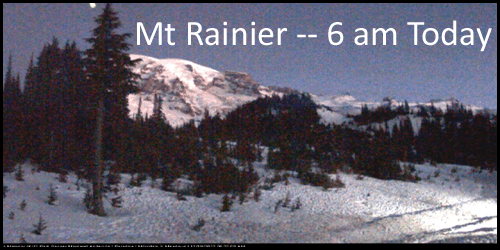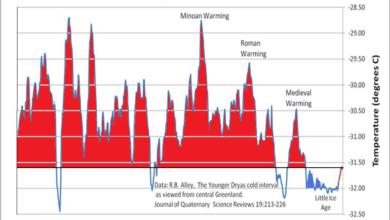What Happens When It Vanishes? – Watts Up With That?

Guest Essay by Kip Hansen — 19 November 2022
The New York Times has become The Guardian of the USA in the sense that when anything appears in it that touches on climate change or even heavy weather, the article is pure Climate Crisis Propaganda and not journalistic news. Although the NY Times is not a member of The Guardian’s co-founded climate news cabal, Covering Climate Now, the NY Times is every bit as dedicated to making every story a climate crisis story.
The latest adventure into fantasyland in the Times is their special photojournalist story titled: “Life Was Built Around Snow. What Happens When It Vanishes?” carrying a sub-title of “The melting of the snowpack in the high Cascades has long been a predictable source of sustenance in the Pacific Northwest. But the old patterns are changing.” by Ruth Fremson (photographer) and Kirk Johnson.
In a pragmatic sense, normally, when the snow vanishes, you know spring has arrived. This is not quite true in this article about snow in the Cascade Range, in which the photos are taken and personal stories are solicited. The photos are gorgeous. The journalism is the propagandist’s favorite style, narrative journalism. Narrative journalism is a refuge for propagandists because they can tell stories that are nominally true, but which contain almost no real facts and are so viewpoint biased that the reader is fooled into believing blatant falsehoods.
The first falsehood is the title itself. “What happens when [snow] vanishes?” Oddly, there are no facts in the story that point to vanishing snow in the Cascades or even complaints that there is not enough snow. What the Times gives us are these:
“Kirk Thomas, a druid priest, fixed his gaze toward the volcano’s summit as the evening colors deepened from rose to purple and the ceremony neared its conclusion. He offered up a blessing. “May the snows always remain on the mountain,” he said.” “Ancient mysteries of the earth and sky are alive and well….”
….
“A pattern of moderation in temperature and precipitation extended through the network of river valleys that flow down from Mount Adams and Mount Hood, another volcano that looms some 50 miles south, across the border in Oregon. Both of them are huge, weather-shaping, snow-catcher mountains that are, for the moment, in seismic slumber: Hood, which stands at about 11,250 feet, was last active roughly 150 years ago; Adams, at 12,280 feet, hasn’t erupted in a thousand years.” (unattributed – refers to a long-term weather pattern)
….
“Salmon are at the center of Yakama Nation culture, going back to the people who arrived thousands of years ago to the area around Mount Adams. “The salmon stood up first to say, ‘I will provide,’” said Kate Valdez, the tribe’s historic preservation officer and a member of the Klickitat Band. That’s why, in any tribal feast, salmon is always given a place of honor at the table. The tribe’s commitment had results and consequences. “We’re going to have fish back in this river because of them, largely,” said G. Thomas Tebb, the director of the Office of the Columbia River at the Washington State Department of Ecology. “Even when the state Fish and Wildlife Department gave up on salmon, the Yakamas never did, and thank God they didn’t.”
….
“Those volcanoes are the water towers for the region,” said Anders E. Carlson, the president of the Oregon Glaciers Institute, a research group. “The wine you drink from river valleys that are fed by glacial meltwater, the salmon in your rivers — those are all intimately linked to a system that has been in equilibrium,” he added. “But now we have perturbed that system.” (Note: Anders E. Carlson seems to be the only member of the Oregon Glaciers Institute.)
Here is the main claim (other than vanishing snow), which is not attributed to any source:
“But the old predictability has been shattered by climate change. Questions of when the snow comes to the high country, when it melts to feed the rivers that supply irrigation and drinking water, how much of the region’s water falls in rainstorms that dump torrents in hours — all these things have become more variable.”
First: What and where are the Cascades? The map above shows the Cascades stretching from Mount Shasta in California, all the way north to the Canadian border (and beyond). Here’s a view some of the peaks:
In the foreground is “Mount Rainier, the range’s highest mountain, standing at 14,411 ft (4,392 m). Seen in the background (left to right) are Mount Adams, Mount Hood, and Mount St. Helens.” (image and quote – Wiki)
Mount Rainer is a dangerous climb for mountaineers and hikers because of the weather (cold and snow) – over the last century, 125 were known to have died on the mountain — 90 were summit climbers and another 35 or so in climbing accidents that were non-summit related. On the 24th of October 2022 the weather report for Rainer read:
Mount Rainier Recreational Forecast National Weather Service Seattle WA 326 AM PDT Mon Oct 24 2022
Stormy weather Monday night and Tuesday will create difficult mountaineering conditions near the summit, with local blizzard- like conditions, strong winds, and near zero visibility. A high level of skill and experience in alpine terrain, including use of GPS, is recommended for navigation and camping in these conditions.
Timberline Lodge, which operates under a special use permit issued by the Mt. Hood National Forest, USDA Forest Service, is mentioned in the Times piece in this segment:
“But the ways the seasons play out are changing, said Jeff Kohnstamm, the president and area operator of Timberline. Spring, in particular, has become harder to predict.
He thinks that skiing into July and August — and the economically important arrival of competitive teams that use the mountain for summer practice — will continue into the foreseeable future.
But as the pattern of snowfall becomes harder to predict, business during the other seasons, like mountain biking in summer, will become increasingly important. And Timberline plans to install its first-ever automated snow-making system to augment snowpack.”

This chart shows snow depths at Timberline Lodge last season. Bit of a slow start, but for Christmas week, they already had a snowbase of 5 feet – and collected another 3 feet by New Years. The majority of the ski season leveled at 8 to 10 feet of base but ratcheted up to 14 feet of base in mid-April. By the end of the official ski season mid-June, Timberline still has over 10 feet of snowbase. They were skiing there into July and August – in t-shirts.
The propaganda hook of this Times piece is Vanishing Snow. But Timberline Lodge complains that the snow that allows skiing into July and August (which is expected to continue for the foreseeable future) last long enough to threaten their summer businesses of hiking and mountain biking.
Not vanishing snow, but too much snow too much of the year.
What about Mt Hood, further north? Weather alert for 24 October called for blizzard conditions:
Mt Hood — Winter Weather Advisory URGENT – WINTER WEATHER MESSAGE
National Weather Service Portland OR 406 PM PDT Mon Oct 24 2022 …
Northern Oregon Cascades-Cascades in Lane County -Including the cities of Santiam Pass, McKenzie Pass, and Willamette Pass
406 PM PDT Mon Oct 24 2022
…WINTER WEATHER ADVISORY IN EFFECT FROM 6 PM TUESDAY TO 6 AM PDT WEDNESDAY ABOVE 4000 FEET…
* WHAT…Snow expected above 4000 feet. Total snow accumulations of up to 8 inches. Winds gusting as high as 40 mph.
* WHERE…Northern Oregon Cascades and Cascades in Lane County.
* WHEN…From 6 PM Tuesday to 6 AM PDT Wednesday. [ source ]
No vanishing snow there either.
But is it more variable, less dependable than previously?
Let’s look at “A New Look at Snowpack Trends in the Cascade Mountains” by Mark T. Stoelinga, Mark D. Albright, and Clifford F. Mass (2009). It’s a little old, but we are looking at the historical record:
The upper half of the figure shows the “90% Melt-out Date” (as numerical day of the year). The long-term average is just over day 180 — about the first week of July, maybe to the 15th. This date leaves enough snow to ski at the summits, like Timberline Lodge, into August. “Maximum Snowpack Date” centers on day 80 – third week of March, at the end of the Cascades winter. The traces show that each of these metrics have been wildly variable over the 80 years shown.
But neither metric appears more variable (thus less dependable) in the most recent 30 years (1980-2010) than in the earliest 30 years (1930-1960).
So, overall?
North American snow cover extent?
This shows Snow Cover Extent as departures from 1991-2020 normals. We can see that Snow Cover was a little higher in the Global Cooling Period (1970s) and a little lower in the late 80s and early 90s. Since 1995 or so it has been very stable. North American Snow Cover Extent (pale blue – emphasis added on graph – kh) has been mostly confined to a narrow band within +/- 0.5 million km2. So, if there is “vanishing snow”, it is not continental.
Snowpack in the Cascades means water in the rivers and streams for Oregon and Washington states. The NY Times piece correctly points this out. But has the Northwest, and the Cascades, suffered reduced streamflow? Well, not this year at least:
In the USDA, Natural Resources Conservation Service map, up to 17 November 2022 (within a day or so of publication of this essay) the answer is “NO, stream flows are mostly normal or above.” Anything Green (90 to 100%) or any shade of Blue (110% – over 150%) is at or over the long-term average. There are a couple of regions a little low – Yellows – but even most of those are near 90%. The right-hand map from the Western Regional Climate Center (WRCC) shows the most recent monthly precipitation data – again, mostly Normal and Above Normal for Washington and Oregon.
What kind of climate is expected? The Köppen Climate Classification map for the Northwest shows that much of Washington and Oregon is dry-ish — classified as “Cold Semi-Arid”, “Cold Desert”, “Warm-Summer Mediterranean” and “Humid Continental – Dry Cool Summer”. The Cascades, subject of this essay, are generally in the purple stripe up the middle, classified as Humid Continental, Dry Cool Summer.
The small bright yellow area at the bottom on the left is Ashland, Oregon. Dry in the summer living off of several reservoirs in the mountains to the east.
The Columbia River is the major river of the region, forming the east-west border between Washington and Oregon. The Columbia River watershed comprises almost all of the states of Washington, Oregon and Idaho – as well pas part of British Columbia. The Hood River runs north to the Columbia from Mt. Hood – seen just above the OR in the map’s “OREGON”. Here’s the water levels in the Columbia at their junction:
There is some variability but no downward trend is present over the decade reported. The Columbia at the Hood has a Minimum Operating Limit, set at 71.4 feet, to keep the dams operating downstream. It has only touched that limit once in a decade. At that point, the streamflow is given as 140,000 cfs (cubic feet per second). At Quincy, Oregon, near the mouth of the Columbia, the stream flow is 254,000 cfs. [ source ] Those massive streamflows are why it is called “The Mighty Columbia”.
And water demand? Both Oregon and Washington are agricultural states (outside of the cities of course). The two major cities have increased their population, since 1950, four- and five-fold:
And, just to make sure we don’t overlook total state populations:
Combined, the two states now have over 12 million people. This is about the same as the population of the Los Angeles Metro Area of 12.5 million (not to be confused with the megalopolis of Los Angeles, which has over 18 million). In 1950, the two-states combined had only about 4 million people.
Bottom Lines:
1. The tag line “The melting of the snowpack in the high Cascades has long been a predictable source of sustenance in the Pacific Northwest. But the old patterns are changing.” is simply not true for the region known as the Cascades and the region that depends on their snowpack. Patterns are not changing and have not greatly changed.
Snow in the Cascades has been variable as long as records have been kept, and it still variable, but not “more variable” now than in the past.
2. The NY Times headline: “Life Was Built Around Snow. What Happens When It Vanishes?” is not even supported by the story under it. There are no complaints from in the narratives that snow has or will vanish. There is one complaint that snow currently lasts too long into the summer months.
3. Overall, Oregon and Washington are dry-ish states. Not as dry as the Southwest, but they have vast areas of desert and arid lands as well as the Mediterranean-like climate regions just to the east of the coastal mountains.
Note: There are rain-forests in the region, mostly along the Pacific coast, where the coastal ranges force the rain to fall on the western slopes. Parts of the Cascades are considered wet coniferous forests.
4. In the drier regions, there are squabbles over water usage as agriculture increases and populations quadruple. These tensions are not caused by less precipitation but rather more by increased demands on the same resources.
5. As always, weather does not remain the same day-to-day, month-to-month, year-to-year, decade-to-decade or even century-to-century. Real measurable changes in weather metrics are expected and not exceptional. It would be exceptional if there have been no changes or weather differences over the last 50-75 years.
6. The new media focus on combining images and emotional narratives in journalism is just a re-imagined form of propaganda. It is effective, and can be used for good – telling important truths — or for evil — promoting lies and advancing false deceitful agendas.
# # # # #
Author’s Comment:
The NY Times has a whole series of this type of story. Most of them promote climate and environmental alarmism and are very Editorial Narrative-driven to support UN and National leftist progressive agendas.
The photography is always fabulous – reminding me of the best of the old National Geographic.
The stories are unfortunately biased and present only a weird view of the world – like the one in this essay, in which the musings of a druid priest are considered facts for us to examine.
Wither journalism?
# # # # #


